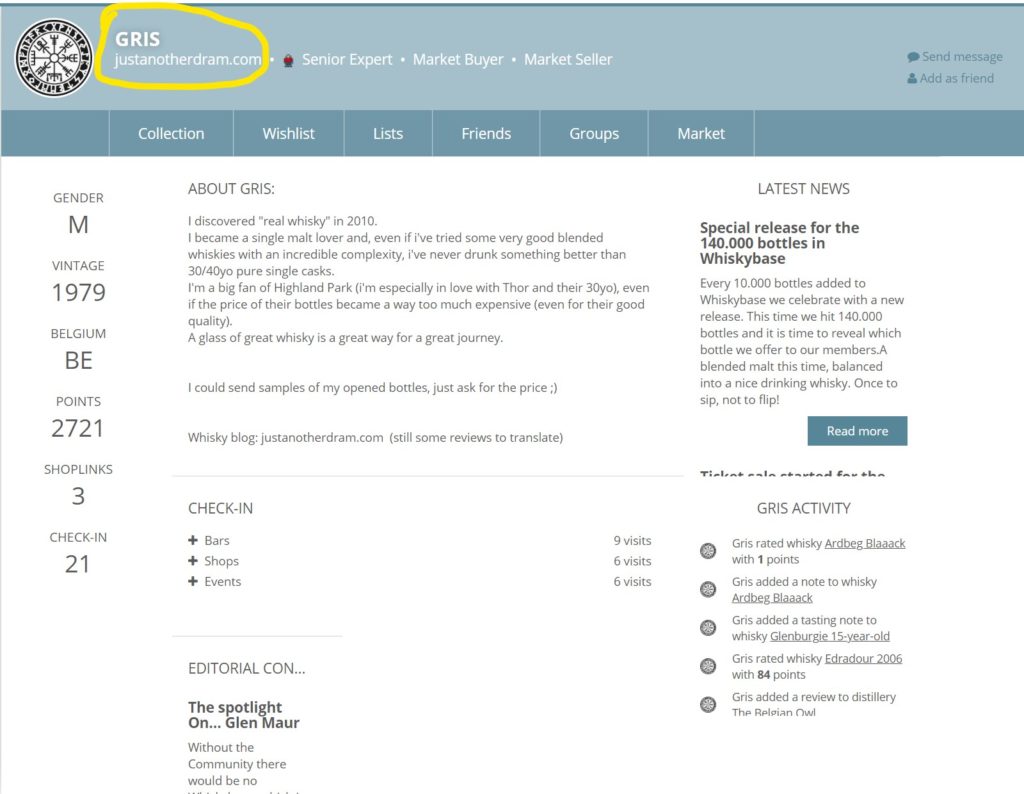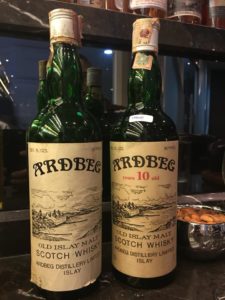english version below
Le site www.whiskybase.com est devenu au fil des années, LA référence pour tout amateur de whisky dans le monde.
Outre une liste impressionnante de 143332 whisky répertoriés (à l’heure où je vous écris ces lignes), le site permet aux utilisateurs de chargés les photos de ces bouteilles, ce qui aide grandement à trouver des informations précieuses comme la valeur de la bouteille.
Une autre grande fonctionnalité est l’attribution d’un cote qui, cumulée et divisée par le nombre de votant, attribue un score au whisky. L’accumulation de ces cotes donnent de la crédibilité à ce score et permet de voir la valeur d’une bouteille augmenter ou diminuer en fonction de cette note plus ou moins élevée.
C’est particulièrement vrai pour les bouteilles n’étant plus sur le marché.
D’ailleurs, nous voyons énormément de collectionneur ou de vendeur se référer à la cote whiskybase pour arguer d’un prix de vente ou d’achat.
Il n’en fallut pas plus à des petits malins pour y voir une possibilité de profit en manipulant ces notations.
Comme en bourse, certains miseront à la hausse sur les cotes cherchant à faire grimper le prix d’une bouteille. Naturellement, tous collectionneur ou revendeur sera tenté de surestimé la cote de son whisky pour faire monter la valeur de sa bouteille.
Par contre, il y a des petits malins encore plus vicieux qui, eux, jouent la cote à la baisse en espérant freiner la valeur de la bouteille ou de la voir diminuer afin de l’acquérir.
Vous me direz, dans les deux cas, c’est de l’escroquerie mais je vais vous expliquer pourquoi le deuxième cas est plus problématique.
Admettons qu’une bouteille ait trois cote : 80, 85, 90 (moyenne de 85). Si un vendeur ajoute une cote de 95 pour faire monter la valeur, la moyenne passera à 87,5 soit seulement 2,5 de plus. Sachant que 99,9% des votants donnent un score entre 75 et 95 (sauf moi qui cote de 0 à 10 puis multiplie par 10), l’impact sera limité. Et la pondération avec le nombre de score donnés fera que la note sera faiblement modifiée. L’impact sur le prix sera minime
Par contre, si un petit malin venait à vouloir baisser la note (mettant 1 à la place de 95), la moyenne tomberait drastiquement à 64… Clairement, un whisky coté à 64, personne ne voudra l’acheté. Et voilà comment notre petit escroc aura manipulé le cours d’une bouteille qu’il souhaite s’acheter.
Je vous mets en photo, un exemple de ce genre de manipulation de cours sur le dernier Ardbeg Blaaack CR.

En cliquant sur le profil, une grosse surprise nous attend. Je vous laisse découvrir qui manipule ainsi les cotes.

Alors, pour répondre à la question : peut-on se fier à une cote whiskybase, je dirais oui mais…
Oui, mais ne vous arrêtez pas à la cote en elle-même : regardez aussi le nombre de votant et, surtout, observez les cotes attribuées et regardez si personne ne tente de les manipuler.
Une cote de 100 peut parfois être suspecte (surtout si la majorité des cotes tournent à 80) mais une cote de 1 est TOUJOURS UNE FAUSSE COTE.
J’espère vous avoir un peu éclairé sur le sujet même si je n’ai pas abordé d’autres facteurs plus pernicieux (sans intention malhonnête) pouvant influencer la cote du whisky.
Cela fera partie d’une prochaine publication.
IS THE WHISKYBASE RATING RELIABLE?
Over the years, the www.whiskybase.com site has become THE reference for all whisky lovers around the world.
Along with an impressive list of 143,332 whiskies on record (as of this writing), the site allows users to upload photos of those bottles, which is a big help in finding valuable information like the value of the bottle.
Another great feature is the assignment of a rating which, combined and divided by the number of voters, assigns a score to the whisky. The accumulation of these ratings gives credibility to this score and allows the value of a bottle to increase or decrease depending on this higher or lower rating.
This is especially true for bottles no longer on the market.
In fact, we see a lot of collectors and sellers referring to the whiskybase rating when arguing about a selling or buying price.
It didn’t take more for smart kids to see a possibility of profit by manipulating these ratings.
As on the stock market, some will bet higher on the odds seeking to drive up the price of a bottle. Naturally, any collector or dealer will be tempted to overestimate the price of his whisky to increase the value of his bottle.
On the other hand, there are even more vicious little clever people who, for their part, play the odds down, hoping to slow down the value of the bottle or see it decrease in order to acquire it.
You will tell me, in both cases, it is a scam but I will explain why the second case is more problematic.
Let’s say a bottle has three ratings: 80, 85, 90 (average of 85). If a seller adds a rating of 95 to increase the value, the average will increase to 87.5 – only 2.5 more. Knowing that 99.9% of voters give a score between 75 and 95 (except for me, who scores 0 to 10 and then multiplies by 10), the impact will be limited. And the weighting with the number of scores given will cause the score to be slightly modified. The impact on the price will be minimal
On the other hand, if a smart guy were to want to lower the note (putting 1 instead of 95), the average would drop drastically to 64 … Clearly, a whisky rated at 64, no one will want to buy it. And this is how our little crook will have manipulated the price of a bottle he wants to buy.
I put you in picture, an example of this kind of price manipulation on the last Ardbeg Blaaack CR.

By clicking on the profile, a big surprise awaits us. I’ll let you find out who is manipulating the odds in this way.

So, to answer the question: can we trust a whiskybase rating, I would say yes but …
Yes, but don’t stop at the odds itself: also look at the number of voters and, most importantly, observe the odds given and see if no one is trying to manipulate them.
Odds of 100 can sometimes be suspect (especially if the majority of odds turn to 80) but odds of 1 are ALWAYS A WRONG RATING.
I hope I have enlightened you a bit on the subject, although I haven’t touched on other more pernicious factors (without dishonest intent) that can influence the rating of the whisky.
This will be part of a future publication.



